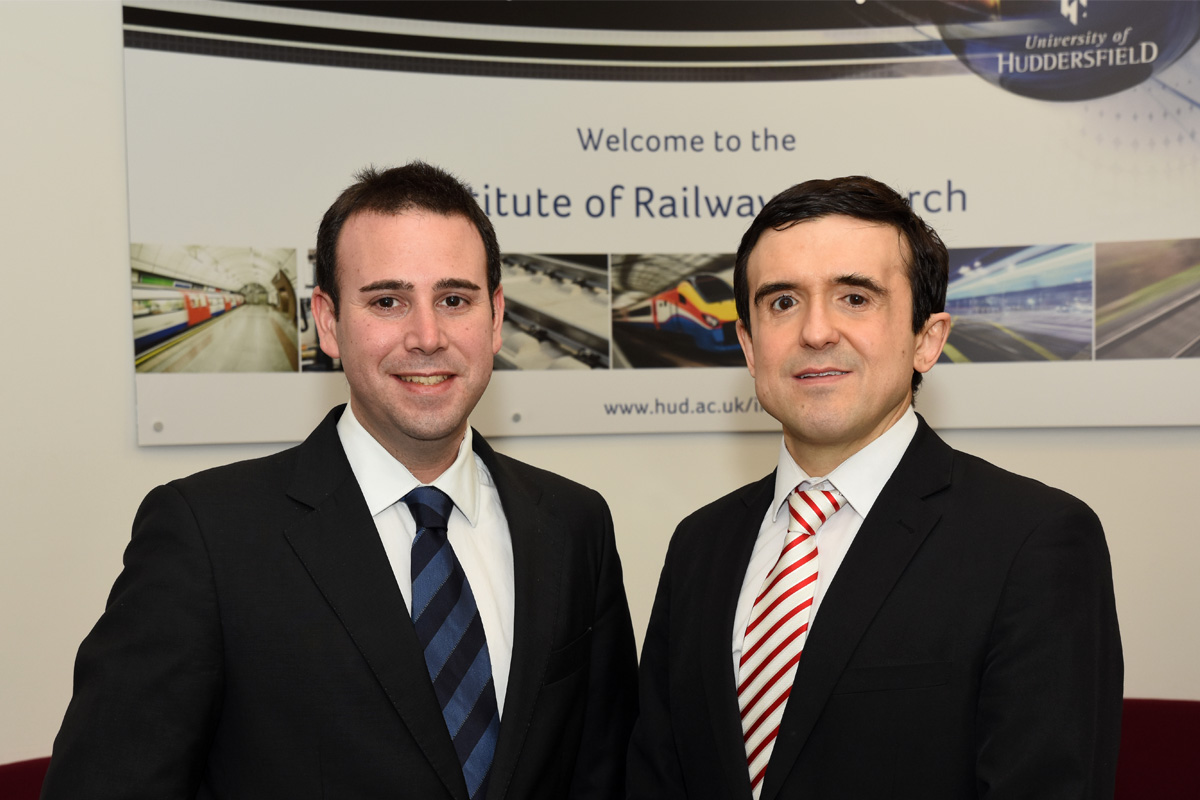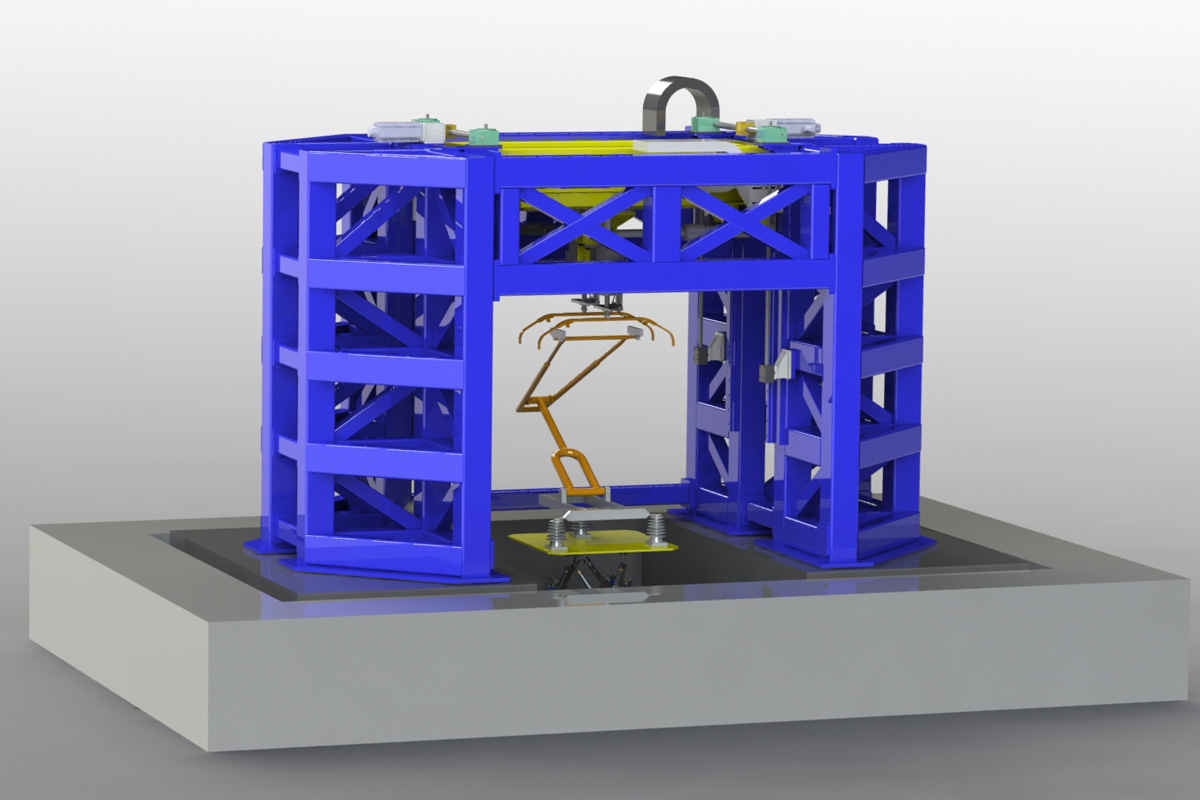The pantograph test rig will sit alongside the Institute’s current £4.5m test rig designed to evaluate vehicular and tracks systems.
 Huddersfield pantograph experts Dr Pedro Antunes (left) and Professor João Pombo
Huddersfield pantograph experts Dr Pedro Antunes (left) and Professor João PomboELECTRIFICATION – leading to improved services and massive reductions in carbon emissions – is the future for railways. But there is a vital need for research that will improve the technology, especially the pantographs that collect current from overhead catenary wires. When they fail, schedules are disrupted and there can be safety risks.
Now, the University of Huddersfield’s Institute of Railway Research (IRR) is to be the site for a world-class, £3.5 million pantograph testing rig. Supervising its design and installation is a professor who is a leading expert in the field.
“We aim to improve pantograph and catenary technologies, to get better current collection, and to support the rail industry, helping it to solve problems,” said João Pombo, who is Professor of Railway Technology at the Institute. He is joined in the work by Senior Research Fellow Dr Pedro Antunes.
The two scientists have taken part in a succession of research projects dealing with pantograph-catenary interaction. For example, the University of Huddersfield’s IRR is leading an ongoing investigation, titled Dynamic Behaviour and Quality of the Current Collection. Part of the EU’s Shift2Rail programme, it has received funding of 700,000 euros and involves universities, institutions and firms from the UK, Italy and Portugal.
One of its goals is to develop new methods – involving reliable computer simulation – that would simplify the acceptance of new pantograph and catenary designs. “The current standards are based on data from the 1980s and 1990s and they are rather strict, preventing the development of new technology,” states Professor Pombo.
His research addresses a wide range of performance, operational and safety issues arising from electrification.
There is a need to improve the quality of current collection, avoiding the problem of “arcing”, when pantographs lose contact with the catenary, resulting in loss of power to the locomotive and high temperatures that deteriorate the contacting elements.
Professor Pombo and Dr Antunes are also exploring ways to reduce wear or damage to pantographs and catenary systems, thereby decreasing the life-cycle costs and avoiding disruptions to rail traffic, such as the serious delays to trains from Paddington in late 2018, when a train brought down some overhead wires.
 Illustration of the new pantograph test rig
Illustration of the new pantograph test rigPantograph test rig ready by 2020
The new test rig at the Institute will be available for research and testing by scientists, engineers and companies from around the world. Currently under construction by Italian conglomerate Simpro, the rig will be installed and operational in the IRR in 2020.
It will be a full-scale rig. Pantographs brought for testing will sit on a moving table that mimics the behaviour of a train and will interact with a virtual catenary, modelled by an advanced computer software.
“The rig is designed to be flexible and will be open for the industry to come to us with a new pantograph or new catenary and ask us to carry out tests in order to de-risk or validate their developments,” said Dr Antunes.
The behaviour and performance of pantographs on high speed lines – such as the UK’s forthcoming HS2 – is one key area of research. For example, Professor Pombo and Dr Antunes have worked with the rail electrification firm KLK on a new design of rigid catenary that could help France’s national rail company SNCF achieve its aim to increase the speed of its trains in some tunnels.
“But the problems are not just associated with high speed. We also want to upgrade conventional speed trains,” said Dr Antunes. “Even a small improvement of 10 or 20 kph in the conventional rail network rail will bring great benefits.”
There are also issues that are specific to the UK, which was an early adopter of electrification but has suffered from low levels of investment in system renewal. Also, the large number of Victorian tunnels with limited levels of clearance pose problems for pantograph-catenary use.
The Director of the Institute of Railway Research, Professor Simon Iwnicki, said: “I am delighted that João and Pedro have joined us. Under João’s leadership, our pantograph research will now be unrivalled in the world and will deliver benefits for the railways and everyone who uses them.”
More news
£4.5m test rig evaluates new two-axle rail vehicle
The Institute of Rail Research is a partner for the new vehicle that will introduce greater passenger comfort, capacity and safety
£30m Centre of Excellence in Rolling Stock
The Centre of Excellence, within the University’s Institute of Railway Research, will develop the rolling stock of the future
Rail research wins IMechE award
Institute of Railway Research’s David Crosbee and Professor Paul Allen won the T.A.Stewart-Dyer Prize/Frederick Harvey Trevithick Prize
